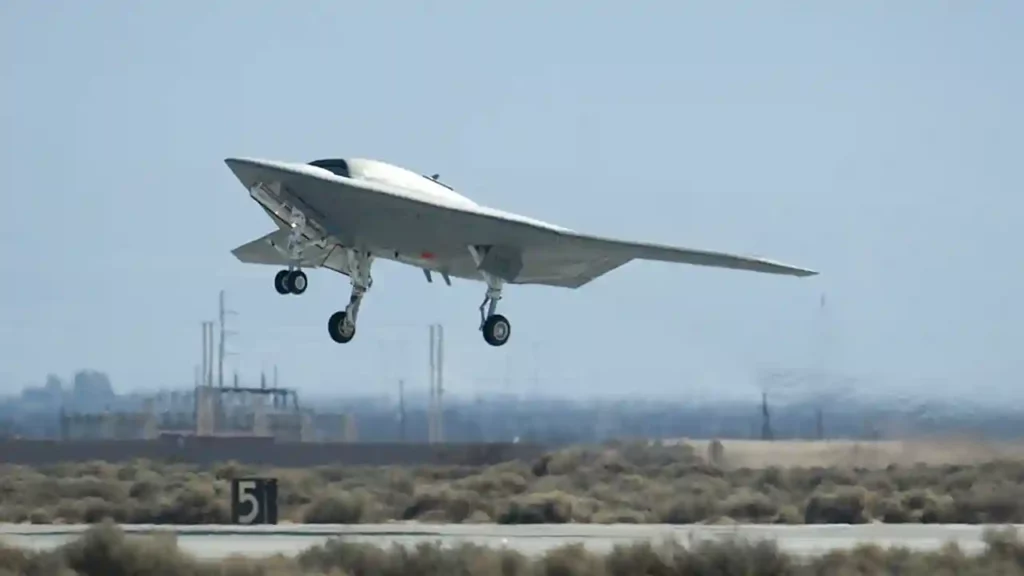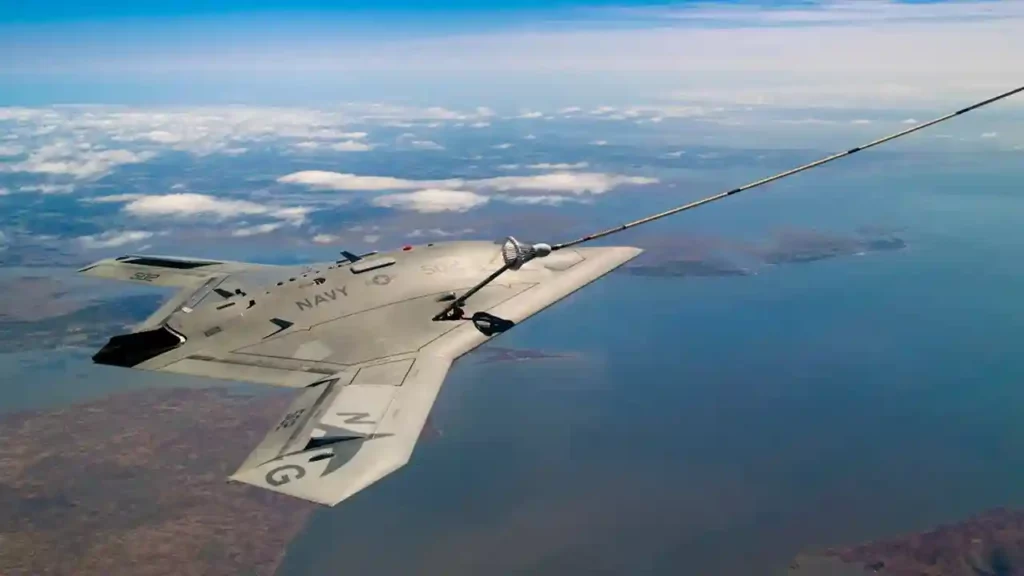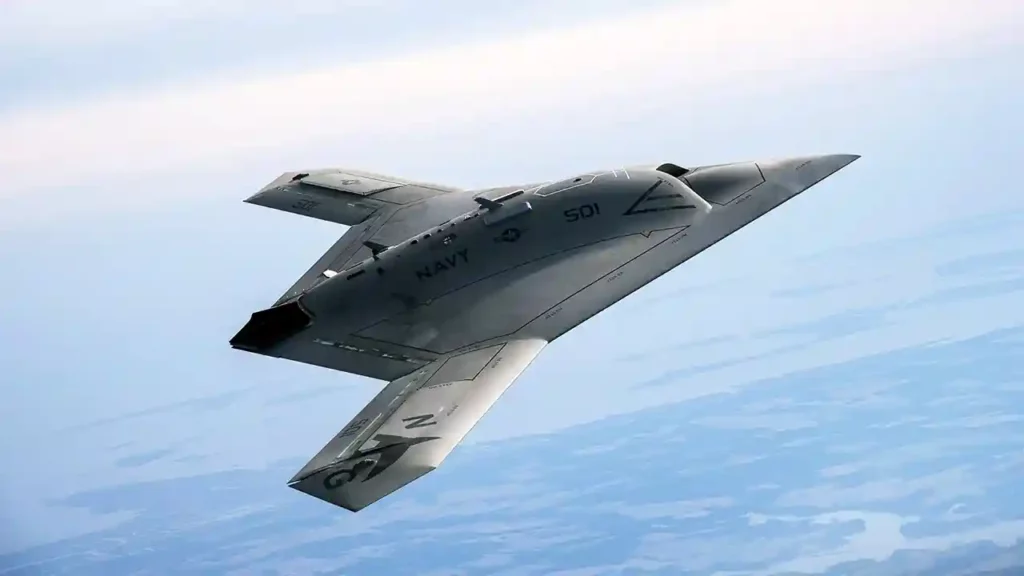Dronelost.com – The Northrop Grumman X-47B is a stealthy, jet-powered, tailless, unmanned combat air vehicle (UCAV) that can operate autonomously from aircraft carriers and other warships.
It is designed to perform a variety of missions, such as reconnaissance, surveillance, strike, and electronic warfare, in high-threat environments.
The X-47B is one of the most advanced and innovative UCAVs in the world, and it has the potential to transform the future of naval warfare.
The X-47B offers many benefits and advantages over traditional manned aircraft, especially in the context of naval warfare. However, the X-47B also faces many challenges and limitations, both technical and operational.
The History and Development of the X-47B

The X-47B is the result of a long and complex development process that began in the late 1990s. The U.S. Navy initiated the Unmanned Combat Air Vehicle (UCAV-N) program in 2000, with the goal of developing a stealthy, carrier-based UCAV that could perform deep strike missions in enemy territory.
The Navy awarded contracts to Boeing and Northrop Grumman to design and build two competing prototypes, the X-45N and the X-47A, respectively.The X-47A, which was based on the earlier X-47 Pegasus demonstrator, made its first flight in 2003.
However, the Navy canceled the UCAV-N program in 2006, due to budget constraints and changing requirements. The Navy then launched a new program, called the Unmanned Combat Air System Demonstration (UCAS-D), to demonstrate the feasibility and maturity of UCAV technologies, such as autonomous carrier operations, networked communications, and air refueling.
The Navy selected Northrop Grumman as the sole contractor for the UCAS-D program, and the company modified its X-47A design into the X-47B. The X-47B is larger and more capable than the X-47A, with a wingspan of 62.1 feet, a length of 38.2 feet, a height of 10.4 feet, and a maximum takeoff weight of 44,567 pounds.
It has a Pratt & Whitney F100-PW-220U turbofan engine, which gives it a maximum speed of Mach 0.9 and a range of over 2,000 nautical miles. It can carry up to 4,500 pounds of weapons in two internal bays, and it has a low-observable design that reduces its radar, infrared, and acoustic signatures.
The X-47B made its first flight in 2011, and since then, it has achieved several milestones and breakthroughs in UCAV technology. In 2013, it became the first UCAV to take off from and land on an aircraft carrier, the USS George H.W. Bush.
In 2014, it became the first UCAV to conduct an autonomous aerial refueling, using a Boeing KC-707 tanker. In 2015, it became the first UCAV to operate in tandem with manned aircraft, such as the F/A-18 Hornet, on an aircraft carrier. The X-47B completed its UCAS-D program in 2015, after demonstrating its reliability, performance, and compatibility with naval operations.
The Benefits and Challenges of the X-47B

The X-47B offers many benefits and advantages over traditional manned aircraft, especially in the context of naval warfare. Some of the benefits are:
- It can operate in hostile and contested airspace, without risking the lives of pilots and crew.
- It can perform missions that are too dull, dirty, or dangerous for humans, such as long-endurance surveillance, suppression of enemy air defenses, and electronic attack.
- It can extend the reach and effectiveness of the carrier strike group, by providing persistent and stealthy coverage, and by enabling distributed and networked operations.
- It can enhance the flexibility and responsiveness of the naval forces, by being able to launch and recover from any suitable platform, and by being able to adapt to changing scenarios and objectives.
- It can reduce the cost and complexity of naval aviation, by requiring less maintenance, manpower, and infrastructure, and by having a longer service life and lower life-cycle cost.
However, the X-47B also faces many challenges and limitations, both technical and operational. Some of the challenges are:
- It relies on secure and robust communication links, which can be disrupted or jammed by adversaries, or affected by environmental factors, such as weather and terrain.
- It has limited autonomy and intelligence, which can limit its ability to cope with unexpected situations, such as malfunctions, threats, or ethical dilemmas.
- It has limited payload and endurance, which can limit its effectiveness and versatility in complex and dynamic missions, such as close air support, air interdiction, and maritime strike.
- It has limited human-machine interaction, which can affect the trust, situational awareness, and decision-making of the operators and commanders, and the coordination and integration with other manned and unmanned assets.
- It has legal and ethical implications, which can raise questions about the accountability, responsibility, and morality of using autonomous weapons systems, especially in lethal and offensive operations.
The Future and Potential of the X-47B

The X-47B is not intended to be a production-ready or operational UCAV, but rather a technology demonstrator and a pathfinder for future UCAV programs. The Navy plans to use the lessons learned and the data collected from the X-47B to inform and guide the development of its next-generation UCAV, the MQ-25 Stingray.
The MQ-25 is expected to be a carrier-based, unmanned aerial refueling and intelligence, surveillance, and reconnaissance (ISR) platform, that will extend the range and endurance of the manned fighter jets, such as the F/A-18 Super Hornet and the F-35C Lightning II. The MQ-25 is scheduled to achieve initial operational capability by 2024, and the Navy intends to procure 72 MQ-25s by 2030.
However, the X-47B also has the potential to be more than just a refueling and ISR platform, and to perform other roles and missions, such as strike, electronic warfare, and anti-submarine warfare.
The Navy has not ruled out the possibility of upgrading and modifying the X-47B to meet these additional requirements, and has expressed interest in exploring the concept of a multi-mission UCAV, that can switch between different modes and functions, depending on the situation and the need.
The Navy has also expressed interest in developing a loyal wingman UCAV, that can operate alongside and augment the capabilities of the manned fighter jets, by providing additional sensors, weapons, and communications.
The X-47B is a revolutionary UCAV that has demonstrated the feasibility and maturity of UCAV technologies, and has paved the way for the future of naval warfare. The X-47B is a testament to the ingenuity and innovation of the Northrop Grumman team, and the vision and leadership of the U.S. Navy.
The X-47B is a game-changer that will enhance the security and superiority of the U.S. and its allies, and will deter and defeat the adversaries and threats of the 21st century.
The Northrop Grumman X-47B is a stealthy, jet-powered, tailless, unmanned combat air vehicle that can operate autonomously from aircraft carriers and other warships. It is designed to perform a variety of missions, such as reconnaissance, surveillance, strike, and electronic warfare, in high-threat environments. The X-47B is one of the most advanced and innovative UCAVs in the world, and it has the potential to transform the future of naval warfare.
